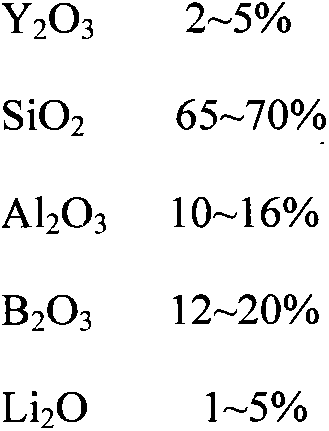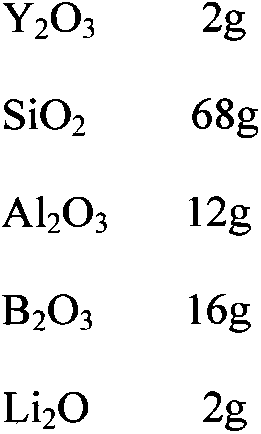A kind of glass powder for all-ceramic dental porcelain and preparation method thereof
The technology of glass powder and porcelain teeth is applied in the field of glass powder for porcelain enamel for all-ceramic teeth and its preparation. sexual effect
- Summary
- Abstract
- Description
- Claims
- Application Information
AI Technical Summary
Problems solved by technology
Method used
Image
Examples
Embodiment 1
[0022] (1) Prepare materials according to the following quality, and fully mix them uniformly:
[0023]
[0024] (2) Place the homogeneously mixed raw materials in step (1) in a frit furnace at room temperature, raise the temperature to 650° C., and keep it warm for 20 minutes, then heat it to 1400° C., and keep it warm for 120 minutes, so that the raw materials are fully fused into molten glass;
[0025] (3) Pour the glass liquid obtained in step (2) into deionized water for water quenching, and the glass liquid forms small glass particles through rapid cooling;
[0026] (4) heat preservation at 100~150° C. for 30 minutes, and dry the glass frit after water quenching;
[0027] (5) Filter out the glass particles obtained in step (4) and grind them with a planetary ball mill to a glass powder with a particle size of 3-5 μm to obtain glass powder for all-ceramic teeth;
[0028] (6) After testing, the softening point of the glass powder is 581°C, and the coefficient of therma...
Embodiment 2
[0030] (1) Prepare materials according to the following quality, and fully mix them uniformly:
[0031]
[0032] (2) Place the homogeneously mixed raw materials in step (1) in a frit furnace at room temperature, raise the temperature to 650°C and keep it warm for 20 minutes, then heat it to 1420°C and keep it warm for 120 minutes, so that the raw materials are fully melted into molten glass;
[0033] (3) Pour the glass liquid obtained in step (2) into deionized water for water quenching, and the glass liquid forms small glass particles through rapid cooling;
[0034] (4) heat preservation at 100~150° C. for 30 minutes, and dry the glass frit after water quenching;
[0035] (5) Filter out the glass particles obtained in step (4) and grind them with a planetary ball mill to a glass powder with a particle size of 3-5 μm to obtain glass powder for all-ceramic teeth;
[0036] (6) After testing, the softening point of the glass powder is 587°C, and the coefficient of thermal exp...
Embodiment 3
[0038] (1) Prepare materials according to the following quality, and fully mix them uniformly:
[0039]
[0040] (2) Place the homogeneously mixed raw materials in step (1) in a room temperature frit furnace, raise the temperature to 650°C, and then keep it warm for 20 minutes, then heat it to 1450°C, and keep it warm for 150 minutes, so that the raw materials are fully melted into molten glass;
[0041] (3) Pour the glass liquid obtained in step (2) into deionized water for water quenching, and the glass liquid forms small glass particles through rapid cooling;
[0042] (4) heat preservation at 100~150° C. for 30 minutes, and dry the glass frit after water quenching;
[0043] (5) Filter out the glass particles obtained in step (4) and grind them with a planetary ball mill to a glass powder with a particle size of 3-5 μm to obtain glass powder for all-ceramic teeth;
[0044] (6) After testing, the softening point of the glass powder is 595°C, and the coefficient of thermal...
PUM
| Property | Measurement | Unit |
|---|---|---|
| particle diameter | aaaaa | aaaaa |
| softening point | aaaaa | aaaaa |
| softening point | aaaaa | aaaaa |
Abstract
Description
Claims
Application Information
 Login to View More
Login to View More - R&D
- Intellectual Property
- Life Sciences
- Materials
- Tech Scout
- Unparalleled Data Quality
- Higher Quality Content
- 60% Fewer Hallucinations
Browse by: Latest US Patents, China's latest patents, Technical Efficacy Thesaurus, Application Domain, Technology Topic, Popular Technical Reports.
© 2025 PatSnap. All rights reserved.Legal|Privacy policy|Modern Slavery Act Transparency Statement|Sitemap|About US| Contact US: help@patsnap.com



